Was Welsh settlers' Patagonia move a success or failure?
- Published
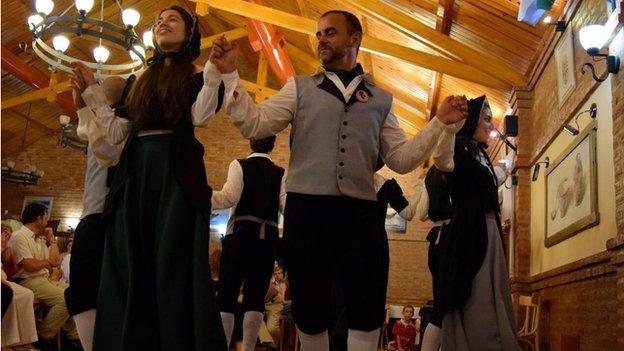
Folk dancing is among the activities held to keep Welsh traditions alive in the town of Gaiman
The 150th anniversary of the arrival of Welsh settlers in Patagonia, Argentina, is being celebrated with events in both countries.
In 2015, how are the communities that were founded by the pioneers doing?
The little Capel Tabernacl is packed out for its Sunday morning service.
As some worshippers stand to give readings or lead the congregation in song, they apologise - in Spanish - for their poor or non-existent Welsh. But when it comes to belting out Welsh hymns they don't seem to stumble over a word.
Outside in the sun, the buzz of conversation is mostly going over my head. It doesn't seem fair. I've spent years battling to learn Spanish and can just about hold my own.
But at this moment in Trelew, Argentina - 40 miles (65km) from where the settlers landed in 1865 to create a colony free from English influence - I can't understand a word most people are saying, because they're speaking Welsh.
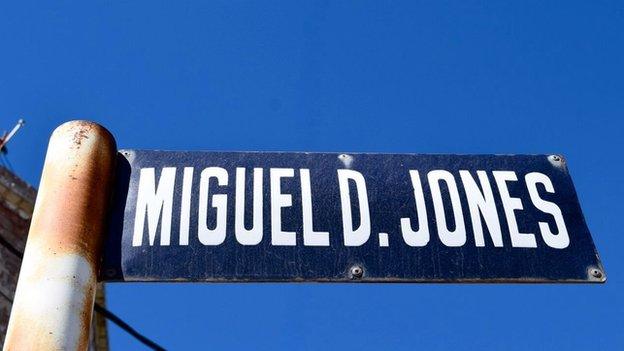
A number of street signs are dedicated to colony founder Michael D Jones
Hailing from Scotland, logic might suggest I should enjoy some linguistic affinity with my fellow Celts.
In fact, I feel doubly foreign. That it's so strange makes it all the more intriguing; so much of Patagonia's Welsh culture has avoided being totally subsumed by that of the eighth largest country in the world.
Over the coming days I spend time at other gatherings of the Welsh-speaking community, at Welsh schools, tea houses and cultural events including harp concerts with folk dancing. The pride people have for their heritage is palpable.
It would be possible, with enough of a selective gaze, to give the impression this is a little Welsh enclave that's been bottled, preserved and labelled 1865.
Of course, that's not the case. While around 50,000 people have Welsh blood and an estimated 5,000 people in Patagonia speak Welsh, it's a minority language and culture in a Spanish-speaking, proudly Latin American, country.
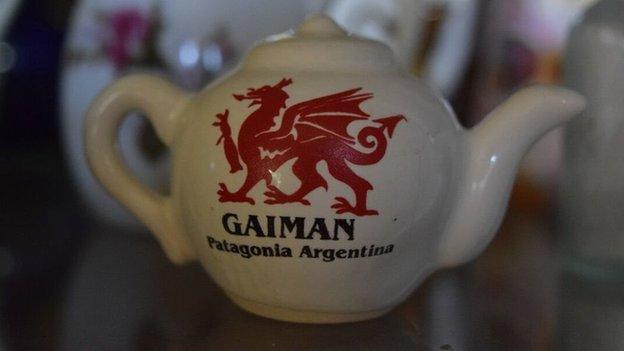
Welsh souvenirs are on sale in many towns in the region
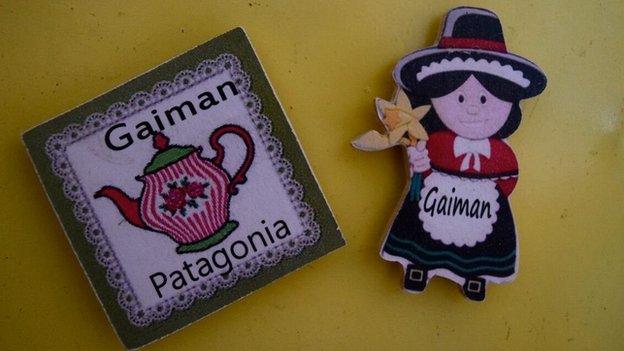
For the most part the Welsh-founded communities of Chubut province, such as Trelew and Gaiman, near the Atlantic coast, and Trevelin and Esquel, 400 miles (644km) west near the Andes, are just getting on with the daily business of being Argentine.
But the threads of Welsh identity undeniably run through them, and in recent decades Argentina has increasingly embraced that legacy as part of its heritage.
Even the casual observer doesn't have to look too hard to find those traces. Just aimlessly walking around will yield street signs dedicated to colony founder Michael D Jones or popular leader John Daniel Evans, who helped the Welsh settlements expand to the Andes region.
One of the reasons for leaving Wales was for the settlers to protect their Protestant non-conformist religion, and the province is dotted with original Welsh chapels.
A card on a shop door in Gaiman advertises Welsh evening classes for adults, a few parked cars display red dragon stickers, and signs welcoming visitors to the town are in Welsh and Spanish.
"A lot of people expect to see us walking around looking like Quakers, in traditional clothes from the 1800s," says Ana Rees, who runs Plas y Coed tea house in Gaiman, where photos of her Welsh ancestors are displayed on the walls, along with souvenir Welsh tea towels and a collection of love spoons.
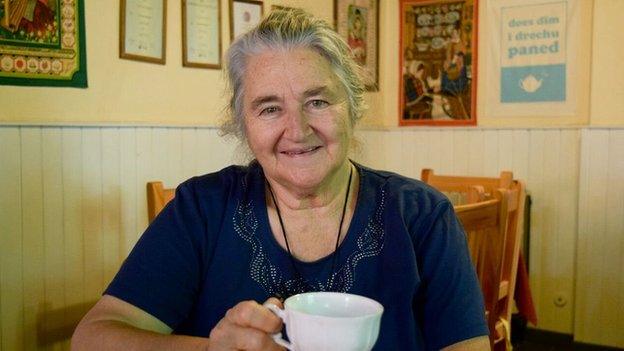
Luned Roberts González is a descendant of the colony's founder Michael D Jones
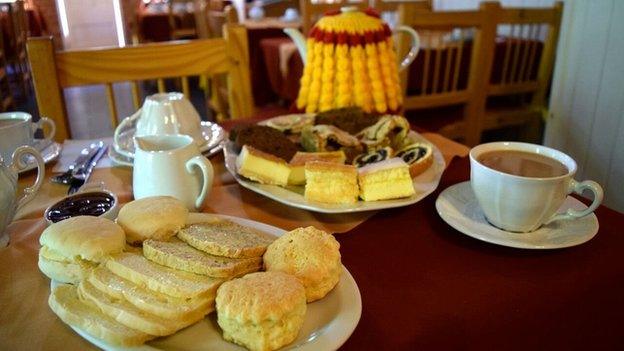
Tea houses serving popular Welsh desserts are popular
In Gaiman and Trevelin in particular, a plethora of Welsh tea houses tempt visitors in with a seemingly unending array of cakes, scones, bread and butter, bara brith, Welsh cakes, cream tarts and pots of tea.
And none are complete without the most famous Patagonian Welsh creation, torta negra - black cake or cacen ddu - which the settlers invented by mixing the traditional bara brith tea loaf and a Christmas cake recipe, to concoct something long-lasting that would see them through times of floods and food shortages.
At Ana's place, I'm making a respectable stab at a giant plate of carbohydrates when Luned Roberts González comes in to refresh herself. She's just come from opening the chapel for a group of cruise ship passengers who, like many tourists these days, have stopped off to see what all the fuss is about.
Mrs González - who is descended from colony founder Michael D Jones - is widely regarded, along with her late sister Tegai Roberts, as what the Argentines might call the "doña" of this most Welsh of Welsh Patagonian communities.
Headteacher at the local Colegio Camwy school for nearly 40 years, she pushed for the language to be included in lessons and gets considerable credit for helping it to remain thriving.
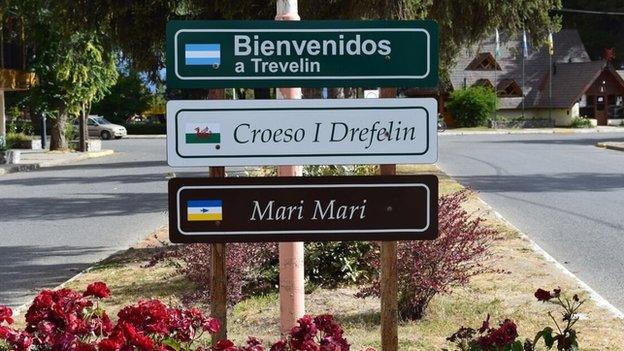
A trilingual sign in Trevelin welcomes visitors
We discuss the renaissance which has seen "Welshness" back in vogue in recent decades, the increased contact with Wales, a rise in Welsh-related tourism and the growing popularity of language learning.
"There is so much talk about the Welsh now, maybe people here sometimes think 'oh, these Welsh again!'" she says.
"When the council decided to put up Welsh signs, some people complained. But there are always people complaining about something.
"Generally everyone is integrated - there are people here of many extractions. Some people become very enthusiastic about the Welshness of this town."
Welshness, but not Welsh, she emphasises.
"Maybe some tourist guides will give the impression that Gaiman is Welsh. It was founded by the Welsh, it has a strong Welsh culture, but it's not a Welsh town," she added.
A few days later I've joined a memorial ceremony in the scrubby desert, 100 miles (160km) west of Gaiman. The service is marking the deaths of three Welsh pioneers, ambushed by indigenous people from another province during a foray to find new settlements in 1884.
It's a sad tale that's not representative of the colonists' positive relationship with the indigenous Tehuelche people who, far from attacking the newcomers, helped them stay alive in the difficult early years.
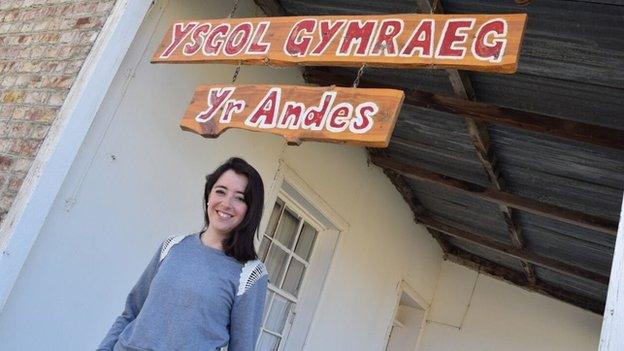
Sara Borda Green has worked to help the Welsh language thrive in her town
Brothers Alejandro and Leonardo Jones, whose great-great grandfather John Daniel Evans was the only survivor of the attack, battle the ferocious Patagonian wind to sing a spine-tingling lament to the lost martyrs.
Among the long list of challenges the settlers faced, it's the weather that's on my mind on the journey across the spectacular Chubut valley towards the Andes, closely mirroring the trips the pioneers made to expand the colony westwards.
That Patagonian wind must have made their life a misery when they arrived in the middle of winter, forced to live in caves for want of proper shelter and aghast at the desolate semi-desert they found. It's a wind that makes everything that bit harder - chilling to the marrow in July and blasting hot dust into every orifice come the summer.
Across the valley, in Trevelin, I meet Sara Borda Green - a 27-year-old teacher and fluent Welsh speaker.
She is fiercely proud of her multi-talented great great grandfather Richard Berwyn Jones, the colony's first registrar, coroner, news reporter and schoolbook author.
Sara is unusual for her generation in that her mother's first language is Welsh.
"I've always kept the language and worked for it. I used to be the only kid reciting in Welsh at the eisteddfod."
"Some think that having Jones or Williams as a name, or dressing up, or singing, is enough to be Welsh. But for me it all makes little sense without the language."
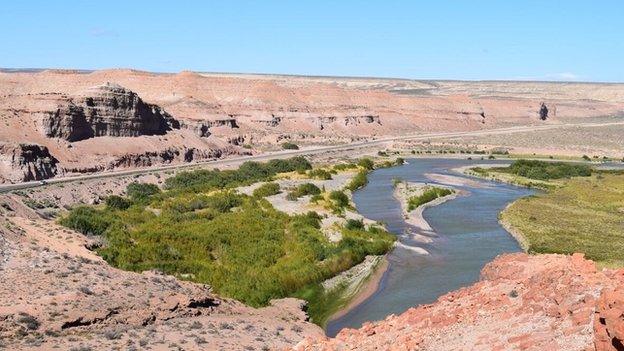
The settlers had to adjust to the harsh weather in the Chubut valley
As in any community, the issue of identity is complex and personal. Not everyone agrees on a single definition of Welshness. Even the anniversary has thrown up some divisions over how it should be celebrated.
"When the Welsh first arrived they were forgotten by the Argentinian government and lots of time passed before there were outside influences.
"That builds a sense of identity more powerful than in a place where everything is easier. When you are alone, you need to be together," she says.
Sara recently co-wrote a paper for a history forum which examined the issue of identity among Welsh Patagonians.
Its title, We Are Still Here, references Welsh hymn Yma o Hyd (Still Here) by Dafydd Iwan, which rose to fame as a nationalist anthem in the 1980s.
"It's saying - and we in Patagonia are saying - that in spite of all the challenges, external pressures, conflicts, in-fighting, whatever it may be, at the end of the day we are still here."

Sailing into the unknown
May 1865 - 153 Welsh settlers sailed on the Mimosa from Liverpool to Argentina, paying £12 per ticket. Arrived 28 July at New Bay (Puerto Madryn)
Five children died, two babies were born, and one couple got married during the journey
The Argentine government - which wanted to populate Patagonia - offered settlers land
Settlers srrived to find inhospitable semi-desert with no shelter and very little food. Flash floods and crop failures dominated early years
Befriended local Tehuelche natives - with their help and the perseverance of settlers, colony flourished and expanded.
Government assimilation policies, immigrant arrivals from other countries, internal disunity and a decline in new Welsh settlers from around WWI, caused stagnation by 1930s
Centenary celebrations in 1965 began increased contact with Wales and started a revival of language and culture. Launch of bilingual eisteddfod opened Welsh culture to all

- Published28 July 2015

- Published28 July 2015
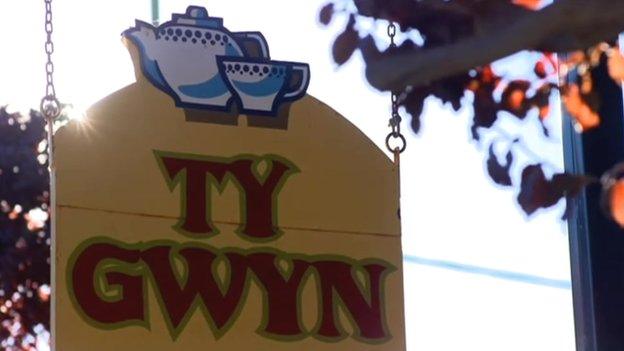
- Published28 July 2015

- Published27 July 2015
